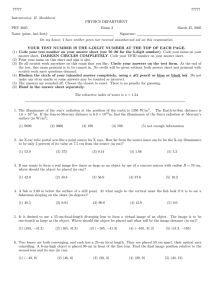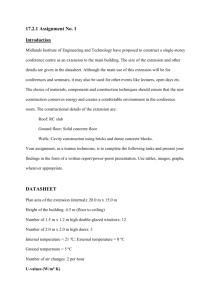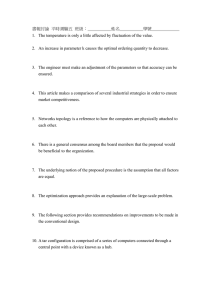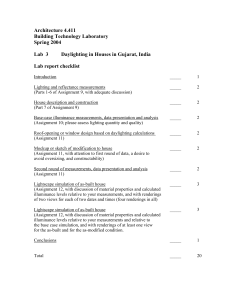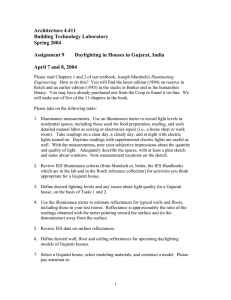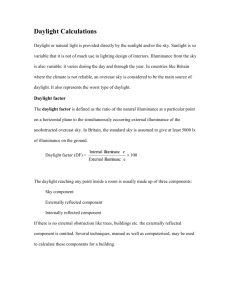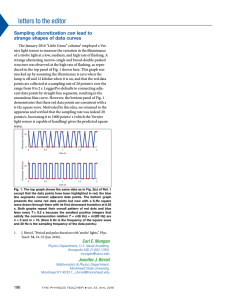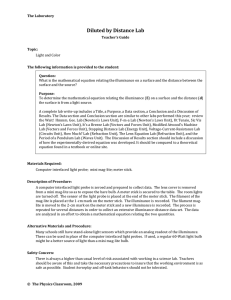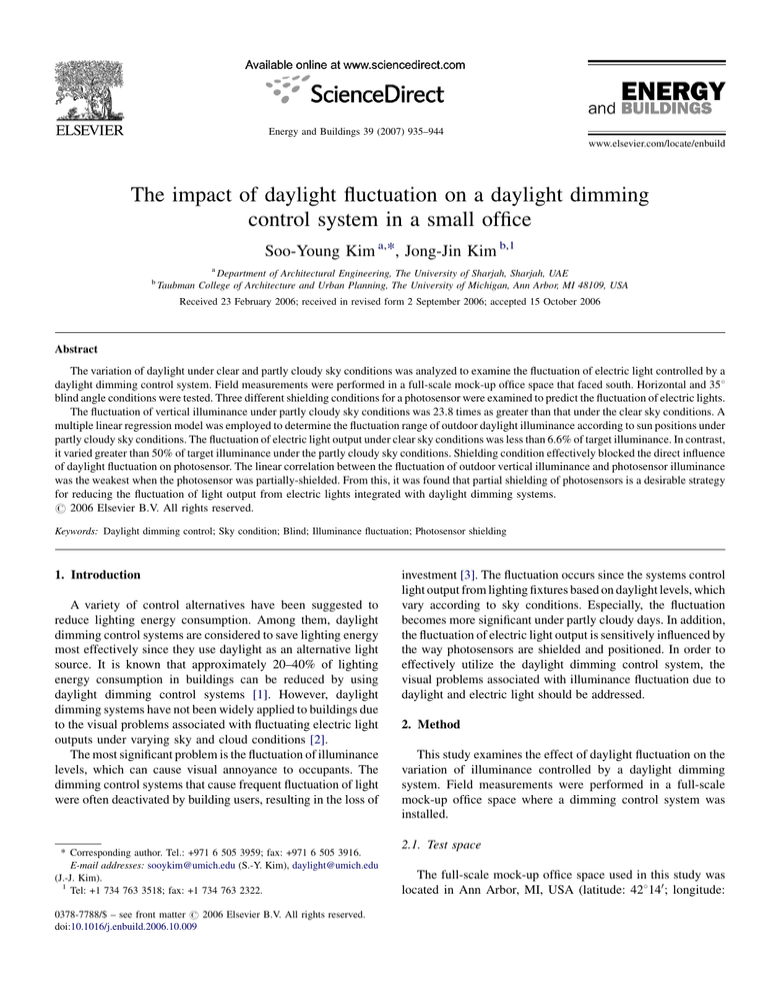
Energy and Buildings 39 (2007) 935–944
www.elsevier.com/locate/enbuild
The impact of daylight fluctuation on a daylight dimming
control system in a small office
Soo-Young Kim a,*, Jong-Jin Kim b,1
b
a
Department of Architectural Engineering, The University of Sharjah, Sharjah, UAE
Taubman College of Architecture and Urban Planning, The University of Michigan, Ann Arbor, MI 48109, USA
Received 23 February 2006; received in revised form 2 September 2006; accepted 15 October 2006
Abstract
The variation of daylight under clear and partly cloudy sky conditions was analyzed to examine the fluctuation of electric light controlled by a
daylight dimming control system. Field measurements were performed in a full-scale mock-up office space that faced south. Horizontal and 358
blind angle conditions were tested. Three different shielding conditions for a photosensor were examined to predict the fluctuation of electric lights.
The fluctuation of vertical illuminance under partly cloudy sky conditions was 23.8 times as greater than that under the clear sky conditions. A
multiple linear regression model was employed to determine the fluctuation range of outdoor daylight illuminance according to sun positions under
partly cloudy sky conditions. The fluctuation of electric light output under clear sky conditions was less than 6.6% of target illuminance. In contrast,
it varied greater than 50% of target illuminance under the partly cloudy sky conditions. Shielding condition effectively blocked the direct influence
of daylight fluctuation on photosensor. The linear correlation between the fluctuation of outdoor vertical illuminance and photosensor illuminance
was the weakest when the photosensor was partially-shielded. From this, it was found that partial shielding of photosensors is a desirable strategy
for reducing the fluctuation of light output from electric lights integrated with daylight dimming systems.
# 2006 Elsevier B.V. All rights reserved.
Keywords: Daylight dimming control; Sky condition; Blind; Illuminance fluctuation; Photosensor shielding
1. Introduction
A variety of control alternatives have been suggested to
reduce lighting energy consumption. Among them, daylight
dimming control systems are considered to save lighting energy
most effectively since they use daylight as an alternative light
source. It is known that approximately 20–40% of lighting
energy consumption in buildings can be reduced by using
daylight dimming control systems [1]. However, daylight
dimming systems have not been widely applied to buildings due
to the visual problems associated with fluctuating electric light
outputs under varying sky and cloud conditions [2].
The most significant problem is the fluctuation of illuminance
levels, which can cause visual annoyance to occupants. The
dimming control systems that cause frequent fluctuation of light
were often deactivated by building users, resulting in the loss of
* Corresponding author. Tel.: +971 6 505 3959; fax: +971 6 505 3916.
E-mail addresses: sooykim@umich.edu (S.-Y. Kim), daylight@umich.edu
(J.-J. Kim).
1
Tel: +1 734 763 3518; fax: +1 734 763 2322.
0378-7788/$ – see front matter # 2006 Elsevier B.V. All rights reserved.
doi:10.1016/j.enbuild.2006.10.009
investment [3]. The fluctuation occurs since the systems control
light output from lighting fixtures based on daylight levels, which
vary according to sky conditions. Especially, the fluctuation
becomes more significant under partly cloudy days. In addition,
the fluctuation of electric light output is sensitively influenced by
the way photosensors are shielded and positioned. In order to
effectively utilize the daylight dimming control system, the
visual problems associated with illuminance fluctuation due to
daylight and electric light should be addressed.
2. Method
This study examines the effect of daylight fluctuation on the
variation of illuminance controlled by a daylight dimming
system. Field measurements were performed in a full-scale
mock-up office space where a dimming control system was
installed.
2.1. Test space
The full-scale mock-up office space used in this study was
located in Ann Arbor, MI, USA (latitude: 428140 ; longitude:
936
S.-Y. Kim, J.-J. Kim / Energy and Buildings 39 (2007) 935–944
838320 ). It was located on the second floor of a three-story
building and faced directly south. Its dimensions were
3 m 4.2 m 2.85 m (10 ft 14 ft 9.5 ft). There were no
obstructing buildings in front of the window. Several trees stood
9 m (30 ft) away from the south façade of the buildings, which
cast shadow on it. The ground in front of the south façade was
covered with grass.
The space was furnished for typical private office use. The
ceiling had 0.6 m 0.6 m (2 ft 2 ft) suspended ceiling grids.
The floor was finished with wood. Wall surfaces were finished
with wall papers with light beige color. A desk and chair were
placed, and a personal notebook computer with 16.1 in. of TFT
screen was located at the center of the desktop. A 1.5 m (5 ft)
high plant was placed near the window, but it did not block the
daylight from the window to desktop.
A 1.42 m 2.02 m (4.75 ft 6.75 ft) window was installed
on the south wall. The window was glazed with single pane
clear glass with 79% of light transmittance. The reflectance of
ceiling, walls and floor were 75%, 60%, and 30%, respectively.
A Venetian blind with 1 in. gap between each slat was installed
on the windows.
The dimensions of a desk were 1.5 m 0.75 m 0.75 m
(5 ft 2.5 ft 2.5 ft). Its geometric center was located at the
centerline of the space. The distance between the window and
the geometric center of the desktop was 16.51 m (6.5 ft). The
reflectance of desk surface was 27%. The detailed dimensions
of the room are shown in Fig. 1.
fixture generated the maximum 1236 cd toward the nadir. The
target illuminance level on the desktop provided by the fixtures
was 750 lx.
The fixtures were controlled by a daylight dimming system
manufactured by the ‘L’ company. The photosensor was located
at the center of the ceiling aiming directly downward. It was
located according to the installation guidelines by the
manufacturer [4]. The location of the photosensor in the room
is shown in Fig. 1.
The ECO-10 electronic fluorescent dimming ballast
installed on the fixture provided dimming ranges between
10% and 100%. The light output was controlled according to
the signal generated by a controller manufactured by the ‘L’
company. The controller was capable of controlling the electric
light output from the lighting fixtures according to the input
signals from the photosensor and its control settings.
Before the initiation of data monitoring procedure, all
possible dimming control algorithms were examined according
to the control setting of the controller. Among them, the control
setting with medium sensitivity was selected to control electric
light output. The setting had the maximum light output when
photosensor illuminance was less than 35 lx (3.25 fc), and the
minimum light output when the illuminance at the photosensor
was greater than 395 lx (36.8 fc). The linear dimming algorithm
used in this study is shown in Fig. 2. This algorithm was used to
analyze the fluctuation of light output from lighting fixture.
2.3. Data monitoring
2.2. Lighting fixture and daylight dimming control system
The lighting fixture used in this study was a recessed
0.6 m 0.6 m (2 ft 2 ft) parabolic fluorescent troffer with
7.62 cm (3 in.) louvers. Two T8 ‘U0 shaped lamps and 3 3
arrays of cells were applied to the luminaire. They consumed
56 W, and the efficiency of lighting fixture was 59%. The
Fig. 1. Layout of the office space.
Photometric sensors and irradiance sensors manufactured by
LI-COR were used for the monitoring of illuminance and
irradiance. They detected illuminance and irradiance in
currents and converted into standard units using calibration
constants assigned for them. The sensitivity of the photometric
sensor was typically 20 mA/100 klx, and the maximum
deviation of linearity was 1% up to 100 klx [5].
An automatically equipped data monitoring system manufactured by Campbell Scientific, Inc. was used for data
recording. The system detected the signals in voltages ranging
from 5 V to +5 V. Its accuracy range is from 2.5 mV to
2.5 mV when temperature is between 0 8C and 40 8C. The
Fig. 2. Photosensor illuminance and electric light output.
S.-Y. Kim, J.-J. Kim / Energy and Buildings 39 (2007) 935–944
937
Fig. 3. Shielding conditions for photometric sensor (left: unshielded; center: partially-shielded; right: fully-shielded).
execution interval for each channel can be up to 250 ms at
100 Hz [6].
Since the photometric and irradiance sensors generated
signals in currents and the data logger detected signals in
voltages, resistances manufactured by LI-COR were installed
between each sensor and channel of data logger in order to
covert the signals into voltage.
A specific computer program was developed to manipulate
the data logger system. The program converted the monitored
voltages into standard units using calibration constants
assigned for the sensors. It also controlled the data logging
process such as the execution period for data monitoring.
The illuminance levels at 15 points and the irradiance
level at 1 point were measured. Two sensors were assigned for
the monitoring of outdoor horizontal and vertical illuminances. Outdoor horizontal irradiance was also measured.
Five sensors were placed for the monitoring of indoor
horizontal illuminance. They were positioned starting from
0.3 m (1 ft) away from the window. Their height was 0.75 m
(2.5 ft) from the floor surface. Three of them were placed on
the desktop. Indoor vertical illuminance levels at the center of
each wall surface were measured. The illuminance levels on a
computer screen and at the position of the viewer’s eye were
monitored.
Three photometric sensors were positioned at the center of
the ceiling in order to monitor the daylight illuminance
according to shielding conditions when the daylight dimming
control system was turned off. Partial shielding, full shielding
and no shielding conditions were applied to the three
photometric sensors as they were applied to the photosensor
connected to the control system.
The field view of the photometric sensor was restricted by
the shielding conditions. The fully-shielded condition showed
67.28 aperture which had 33.68 half angle of a field view. The
partially-shielded photometric sensor was shielded from
the window but open to the rear area of the room. The
partially-shielded condition blocked half of the field view
of the photosensor. The reflectance of the inside of the
shielding material was 75%. Detailed description of shielding
conditions applied to the photometric sensors is shown in
Fig. 3.
The blind control conditions were no blinds (unobstructed
clear glazing), horizontal blinds oriented at 08, and 358
applying the reflectance of 83% for the blind slats. The data
monitoring were performed from April 1, 2003 to August 31,
2003. The daily monitoring periods were from 07:00 to 20:00.
The monitoring intervals were 1 min and 5 min.
3. Results
The illuminance fluctuation was defined as the difference in
illuminances at two moments of measurement. In order to
examine the influence of sky conditions on, the monitored data
were classified into two categories; clear sky and partly cloudy
sky conditions. The classification was based on the ratio of
diffuse solar radiation to global solar radiation, which was
recommendation by the Illuminating Engineering Society of
North America (IESNA) [7]. For a clear sky day, the ratio is less
than 0.3. For a partly cloudy sky condition, the ratio ranges
from 0.3 to 0.8.
3.1. Fluctuation of outdoor daylight illuminance
Overall, the fluctuation of vertical and horizontal illuminance under partly cloudy sky was much significant compared
to the fluctuation under clear sky conditions. In particular, the
fluctuation of vertical illuminance under partly cloudy sky
conditions was 23.8 times greater than the fluctuation under the
clear sky condition.
It appears that the photosensor signal in the space was
significantly influenced under the partly cloudy sky conditions,
and the light output from lighting fixtures fluctuates within a
great range. Approximately 51.1% of fluctuation in vertical
illuminance was between 2000 lx and 5000 lx. The frequency
analysis for the fluctuation of outdoor illuminance is shown in
Table 1. More detailed frequency analysis for the vertical
938
S.-Y. Kim, J.-J. Kim / Energy and Buildings 39 (2007) 935–944
Table 1
Frequency analysis for outdoor illuminance fluctuation [unit: lx]
Statistics
Clear sky
N
Mean
Standard error of mean
Standard deviation
Minimum
Maximum
Partly cloudy sky
Vertical
Horizontal
Vertical
Horizontal
11,160
301.44
3.97
418.90
0
2000
11,160
1659.35
40.15
4242.01
0
65,470
1704
9077.62
207.41
8561.80
2010
47,753
1704
23,864.45
577.73
23,848.32
–
110,400
illuminance under partly cloudy sky conditions is shown in
Table 2.
The variation patterns of outdoor illuminance for a clear and
partly cloudy sky conditions are shown in Figs. 4 and 5.
Outdoor daylight illuminance under clear sky conditions
increased constantly as the altitude of the sun increased. The
illuminance on the south façade of building is strongly
influenced by the sun position. The outdoor horizontal and
vertical illuminance levels show a very stable changing pattern
for all day except on several occasions in the morning.
Under partly cloudy sky day conditions, the sun is frequently
blocked by clouds. Due to this reason, outdoor daylight level
changes suddenly and becomes unstable. The altitude and
azimuth of the sun did not strongly influence the daylight levels
as they did under clear sky conditions. During the time when the
sun was on the south, the daylight level did not reach the
maximum value since the sun was blocked by clouds. This
indicates that outdoor daylight levels do not correlate with the
position of the sun when the sun was blocked by clouds under a
cloudy sky day condition. The daylight levels frequently
fluctuated due to the effect of clouds. When the sun is exactly
due south, the daylight illuminance is the highest if the sun is
not blocked by the clouds. However, once the clouds block the
sun and release it, the change of daylight levels becomes
Table 2
Frequency analysis for outdoor vertical illuminance fluctuation (partly cloudy
sky)
Fluctuation range [lx]
From
To
2001
2501
3001
3501
4001
4501
5001
5501
6001
6501
7001
7501
8001
8501
9001
9501
2,500
3,000
3,500
4,000
4,500
5,000
5,500
6,000
6,500
7,000
7,500
8,000
8,500
9,000
9,500
10,000
Frequency
Percent
238
174
127
99
88
75
70
54
50
34
44
28
33
25
31
25
14.97
10.21
7.45
5.81
5.16
4.40
4.11
3.17
2.93
2.00
2.58
1.64
1.94
1.47
1.82
1.47
Fig. 4. Variation of outdoor daylight illuminance (clear sky, June 23, 2003).
Fig. 5. Variation of outdoor daylight illuminance (partly cloudy sky, July 6,
2003).
pronounced. Daylight illuminance under partly cloudy sky
conditions are not strongly correlated to the sun position
compared to clear sky conditions. The conditions of cloud are
more critical factors to the fluctuation of daylight illuminance.
3.2. Prediction for the fluctuation of outdoor daylight
illuminance
Multiple linear regression was used to develop the prediction
model for the fluctuation of outdoor daylight illuminance level
under partly cloudy sky conditions. For the monitored
illuminance data, the absolute value of fluctuation range in
outdoor vertical illuminance level was considered to be the
dependent variable. This was because indoor daylight
illuminance is significantly influenced by the outdoor vertical
illuminance that arrives at a window surface. The fluctuation
range was determined by subtracting the former illuminance
from the latter illuminance between the consecutively
monitored illuminance data.
The altitude and azimuth of the sun were considered to be
independent variables in the prediction model. In this study, the
altitude and azimuth before noon were equal to those in
afternoon, since the data monitoring was performed in a
S.-Y. Kim, J.-J. Kim / Energy and Buildings 39 (2007) 935–944
south-facing space. The azimuth ranged from 1008 to 1008
and the altitude varied from 08 to 728. The influence of the area
and density of clouds on the fluctuation was not considered in
the prediction model.
In order to develop the prediction model for partly cloudy
sky conditions, the illuminance change patterns were categorized according to the fluctuation range. The data representing
partly cloudy sky conditions were divided separately so that
they could be used for multiple regression models.
First, scatter plots were prepared to diagnose what type of
relationship existed between the independent and dependent
variables. It seemed that the relationship could be explained by
a polynomial function rather than linear function. Hence, a
standard second degree polynomial regression model was
selected using altitude and azimuth. The model is expressed as
follows:
939
Fig. 6. Relationship between altitude and outdoor vertical illuminance fluctuation (partly cloudy sky, April 2003–August 2003, transformation Y0 = log10 Y).
Y ¼ b0 þ b1 ðQÞ þ b2 ðQÞ2 þ b3 ðaÞ þ b4 ðaÞ2 þ b5 ðQÞðaÞ þ eo
where Y is the fluctuation range of outdoor vertical daylight
illuminance [lx]; Q the altitude [degrees]; a the azimuth
[degrees].
It appeared that the plot between altitude and daylight
illuminance fluctuation had unequal error variances since the
plot showed a prototype of regression patterns where the error
variances increase with independent variable. Therefore, it was
necessary to perform a transformation on the dependent
variable. It was expected that the transformation will result in
higher correlation, and the variability of fluctuation level at
different altitude will be constant. According to the prototype
regression pattern, the logarithmic transformation was used.
The transformation is expressed as follows:
Y 0 ¼ log10 Y
where Y is the originally calculated fluctuation range of vertical
daylight illuminance [lx]; Y0 is the transformed fluctuation
range of vertical daylight illuminance [lx].
Next, a scatter plot between independent variables and the
transformed fluctuation range (Y0 ) was prepared. After it was
confirmed that a polynomial relationship existed between them,
a multiple regression model for the fluctuation of daylight
illuminance was developed using SPSS (Statistical Package for
Social Science). The model was tested with a significant level
of 0.05 to examine whether it was acceptable.
Finally, the significance level for each independent variable
in the prediction model was examined to asses whether all
independent variables were significant contributors to the
fluctuation range of the illuminance. The interaction between
altitude and azimuth was also examined. The results indicated
that altitude and azimuth were critical contributors, but no
interaction existed between them (t = 0.02, p > 0.05). Therefore, the prediction model was adapted excluding the
interaction between altitude and azimuth.
The scatter plots between the transformed daylight
fluctuation and altitude, and azimuth are in Figs. 6 and 7.
The final regression model should be expressed in terms of
original fluctuation range of vertical daylight illuminance (Y),
Fig. 7. Relationship between azimuth and outdoor vertical illuminance fluctuation (partly cloudy sky, April 2003–August 2003, transformation Y0 = log10 Y).
since transformation was used. Using antilog, the prediction
model is expressed as follows:
Original fluctuation range
¼ antilog½1:1652 þ 0:1136ðQÞ 0:0011ðQÞ2 0:0003ðaÞ
0:0001ðaÞ2 The ANOVA analysis results performed in this study
indicated that the altitude (t = 14.44, p < 0.05) and azimuth
(t = 1.43, p < 0.05) were important contributors to the
fluctuation range of outdoor vertical daylight illuminance.
Although the coefficients for each parameter were not great, the
prediction model was acceptable within 5% of significance
level. The ANOVA analysis result indicated that linear
relationship existed between the fluctuation range of outdoor
vertical daylight illuminance and altitude, and azimuth, F (2,
1712) = 354.79, p < 0.05.
However, the coefficient of determination for the model was
not very high (r2 = 0.453). It appears that this low correlation
occurred because the daylight illuminance levels showed
greater or smaller fluctuation ranges under partly cloudy sky
940
S.-Y. Kim, J.-J. Kim / Energy and Buildings 39 (2007) 935–944
days, although the altitude and azimuth varied steadily during
the data monitoring period.
In general, the outdoor daylight illuminance under a clear
sky condition increases as the altitude of the sun increases. If
clouds block the sun and release it again when the altitude was
high, the fluctuation range of daylight illuminance becomes
greater. On the other hand, the fluctuation range is small if the
sun is blocked and released at lower altitude conditions. In this
research, the full-scale mock-up test place was facing south.
Therefore, the fluctuation range was very wide when the sun
was blocked by the clouds at higher altitude conditions.
The other factor that influenced the outdoor daylight
illuminance was the conditions of clouds, for example, the
area, thickness and density of clouds in the sky. Under the
same altitude condition, the fluctuation range of daylight
illuminance might be very low or significantly great according
to the conditions of clouds. Although the effect of cloud
condition was not considered in the model, the data used for the
prediction model indicated that the fluctuation range was
significantly affected by the presence of clouds when the altitude
was high.
3.3. Illuminance fluctuation at photosensors and
workplane
The fluctuation of illuminance under a partly cloudy sky
conditions were significantly greater than that of clear sky
conditions. Under clear sky conditions, it appears that the blind
angle was not an important factor to the fluctuation of
photosensor illuminance and the electric light output from
lighting fixture.
The mean value of fluctuation on workplane was within
3.87 lx, which is very small. The fluctuation at photosensors did
not show significant difference according to the shielding
conditions. The difference in fluctuation was less than 3 lx for
all shielding conditions when the blinds were angled. The
photosensor illuminance fluctuated within 3.44 lx when the
unshielded condition was used.
The electric light output from lighting fixture can be
controlled stably under a clear sky day regardless of the
shielding conditions, since the variation of photosensor
illuminance was not strongly influenced by the stable change
of daylight.
Under partly cloudy sky conditions, the blind angle was not
an important factor in the fluctuation of illuminance, since the
fluctuation did not show significant differences according to the
blind angles. However, the shielding conditions were effective
contributors to preventing high fluctuation of photosensor
illuminance.
The unshielded conditions seem to be significantly
influenced by the change outdoor illuminance. However, the
two shielded conditions effectively reduced the fluctuation
under partly cloudy sky conditions. In particular, the mean
value of fluctuation at the photosensors showed a difference up
to 38.76 lx when the unshielded and partially-shielded
conditions were used.
The fluctuation caused by partially-shielded and fullshielded conditions did not show significant difference. The
electric light output would be stably controlled without
significant fluctuation when shielding conditions were applied
to photosensors. A summary of illuminance fluctuation at
photosensors and workplane is shown Table 3. Frequency
analysis for the fluctuation is shown in Tables 4–7.
3.4. Correlation analysis
The fluctuation of illuminance at photosensors and desktop
is significantly influenced by the variation of outdoor daylight
illuminance. In particular, the fluctuation of illuminance at
photosensor is a very critical factor in controlling the electric
light output from lighting fixtures.
In this study, linear prediction models were developed to
determine the relationship between the fluctuation of outdoor
vertical illuminance and the variation of illuminance at
photosensors and desktop under partly cloudy sky conditions.
The prediction models used the method of least squares that
Table 3
Daylight illuminance fluctuation at photosensors and workplane [unit: lx]
Statistics
Horizontal blind
358 blind
Desktop
Un-shielded
Partially-shielded
Fully-shielded
Desktop
Un-shielded
Partially-shielded
Fully-shielded
Clear sky
N
Mean
Standard error of mean
Standard deviation
Minimum
Maximum
6258
3.87
0.08
6.29
0
49
6258
3.31
0.07
5.43
0
47
2859
1.49
0.07
3.56
0
17
2859
1.82
0.07
4.01
0
31
4876
3.59
0.10
6.84
0
65
4876
3.44
0.09
6.43
0
55
2848
1.17
0.06
3.14
0
17
2848
1.21
0.06
3.24
0
23
Partly cloudy sky
N
Mean
Standard error of mean
Standard deviation
Minimum
Maximum
967
66.11
2.54
78.92
0
471
967
58.24
2.22
68.92
0
415
712
19.48
0.80
21.31
0
114
712
30.59
1.34
35.71
0
203
737
57.01
2.19
59.56
0
260
737
52.52
1.94
52.58
0
235
574
18.30
0.81
19.31
0
90
574
24.22
1.05
25.20
0
102
S.-Y. Kim, J.-J. Kim / Energy and Buildings 39 (2007) 935–944
941
Table 4
Frequency analysis for the fluctuation of daylight illuminance (clear sky, horizontal blind)
Fluctuation range [lx]
Desktop
Unshielded
Partially-shielded
Fully-shielded
Frequency
[%]
Frequency
[%]
Frequency
[%]
Frequency
[%]
<50
6258
100
6258
100
6258
100
6258
100
Total
6258
100
6258
100
6258
100
6258
100
Table 5
Frequency analysis for the fluctuation of daylight illuminance (clear sky, 358 blind)
Fluctuation range [lx]
Desktop
Frequency
<50
51–100
4870
6
Total
4876
Unshielded
[%]
99.98
0.12
100
Frequency
Partially-shielded
[%]
4874
2
4876
99.96
0.04
100
Fully-shielded
Frequency
[%]
Frequency
[%]
4876
100
4876
100
4876
100
4876
100
Table 6
Frequency analysis for the fluctuation of daylight illuminance (partly cloudy sky, horizontal blind)
Fluctuation range [lx]
Desktop
Frequency
<50
51–100
101–150
151–200
201–250
251–300
301–350
351–400
401–450
451–500
609
173
81
41
18
20
10
5
5
5
Total
967
Unshielded
[%]
62.98
17.89
8.38
4.24
1.86
2.07
1.03
0.52
0.52
0.52
100
Frequency
648
148
77
47
23
9
5
8
2
967
Partially-shielded
[%]
67.01
15.31
7.96
4.86
2.38
0.93
0.52
0.83
0.21
100
Frequency
662
42
8
712
Fully-shielded
[%]
92.98
5.90
1.12
100
Frequency
578
93
26
13
2
712
[%]
81.18
13.06
3.65
1.83
0.28
100
Table 7
Frequency analysis for the fluctuation of daylight illuminance (partly cloudy sky, 358 blind)
Fluctuation range [lx]
Desktop
Frequency
<50
51–100
101–150
151–200
201–250
251–300
479
125
58
39
31
5
Total
737
Unshielded
[%]
64.99
16.96
7.87
5.29
4.21
0.68
100
Frequency
487
119
73
44
14
737
minimizes the error sum of square (SSE) between the two
variables.
The models were tested with a significant level of 5% to
examine whether they were acceptable. For all cases, the test
results indicated that the linear prediction models were
acceptable. The coefficients of determination (r2) of the
models were greater than 0.88 for horizontal and 358 blind
conditions. It means that the variation in mean response for the
overall illuminance fluctuation at photosensors and desktop
Partially-shielded
[%]
66.08
16.15
9.91
5.97
1.90
100
Frequency
534
40
574
Fully-shielded
[%]
93.03
6.97
100
Frequency
487
81
6
574
[%]
84.84
14.11
1.05
100
was reduced more than 88%, when the outdoor vertical
illuminance was considered in the prediction models. The
detailed regression and test results are in Table 8.
For horizontal and 358 blind conditions, the unshieldedphotosensor showed the best correlation, while the partiallyshielded photosensor had the weakest correlation among three
photosensor conditions. It implies that the electric light output
from lighting fixture could fluctuate very sensitively when an
unshielded photosensor is used for a daylight dimming control
942
S.-Y. Kim, J.-J. Kim / Energy and Buildings 39 (2007) 935–944
Table 8
Correlation between the fluctuation of outdoor vertical daylight illuminance and the variation of illuminance at photosensors and desktop
Blind
Fluctuation of daylight illuminance at
Prediction model
r2
F
Sig.
358
Desktop
Unshielded
Partially-shielded
Fully-shielded
Y = 0.007 OVF 5.164
Y = 0.006 OVF 2.076
Y = 0.002 OVF 1.638
Y = 0.003 OVF 2.484
0.943
0.939
0.88
0.926
12,030.8
11,098.9
4121.13
6998.7
0.00
0.00
0.00
0.00
Horizontal blind
Desktop
Unshielded
Partially-shielded
Fully-shielded
Y = 0.009 OVF 10.067
Y = 0.008 OVF 8.620
Y = 0.002 OVF 1.370
Y = 0.004 OVF 4.804
0.923
0.939
0.891
0.913
11,278.2
14,406.24
5673.7
7304.1
0.00
0.00
0.00
0.00
OVF: fluctuation of outdoor vertical daylight illuminance [lx].
The fluctuation of electric light output was predicted using
linear regression models. They were developed under partlycloudy sky conditions since outdoor illuminance did not
significantly fluctuate under clear sky conditions. Three
photosensor shielding conditions and two blind angles were
considered in the models. A significant level of 5% was used to
determine the acceptability of the models.
The fluctuation of electric light output was influenced by
blind angles and the variation of outdoor vertical illuminance.
The fluctuation range of light output under horizontal blind
conditions is greater than that under a 358 blind condition. The
difference in fluctuation was approximately 10%. The electric
light output was more easily influenced by the change of
outdoor vertical illuminance, since the horizontal blind angle
had more wide area of opening between blind slats than 358
blind.
Photosensor shielding conditions were a significant factor to
the fluctuation of light output. They significantly reduced the
fluctuation. Overall, the unshielded photosensor condition
caused the greatest fluctuation range. When the horizontal blind
was used, the unshielded condition showed up to 90% of
fluctuation in light output. The partially-shielded photosensor
caused the least variation of light output. The maximum
fluctuation was less than 23% of total light output when the
change of outdoor vertical illuminance was 47,543 lx.
Below 5000 lx of change in outdoor vertical illuminance, the
light output was not significantly influenced by the shielding
conditions. As the change of outdoor vertical illuminance
became greater than 10,000 lx, the shielding conditions
effectively reduced the fluctuation of light output. The
Fig. 8. Relationship between the fluctuation of electric light output and outdoor
vertical illuminance fluctuation (partly cloudy sky, 358 blind).
Fig. 9. Relationship between the fluctuation of electric light output and outdoor
vertical illuminance fluctuation (partly cloudy sky, horizontal blind).
system. The unshielded condition would cause a wide range of
illuminance fluctuation on desktop when the fluctuation range
of outdoor illuminance was great.
However, the fluctuation of illuminance was less influenced
by the variation of outdoor vertical illuminance when a
partially-shielded condition was used. This study recommends
that the partially-shielded photosensor condition can be
effectively applied to minimize the fluctuation of light output
from lighting fixture.
It is interesting that the correlation for a fully-shielded
condition was lower than that of partially-shielded condition.
The difference ranged from 0.032 to 0.046. This result occurred
due to difference of viewing angle caused by the shielding
conditions. The fully-shielded photosensor detected the change
of illuminance on desktop which was significantly influenced
by the variation of outdoor illuminance. However, the partiallyshielded photosensor was shielded from the window but open to
the rear area of the room. Due to this configuration, the
photosensor detected the reflected light from the back wall and
rear part of the sidewall which was less significantly influenced
than the variation of illuminance on desktop area.
3.5. Prediction of fluctuation of electric light output
S.-Y. Kim, J.-J. Kim / Energy and Buildings 39 (2007) 935–944
943
Table 9
Fluctuation of electric light output
Blind
Fluctuation of electric light output by
Model
r2
F
Sig.
358
Unshielded
Partially-shielded
Fully-shielded
Y = 0.015 OVF + 0.0997
Y = 0.004 OVF 0.1260
Y = 0.006 OVF 0.1891
0.9707
0.7969
0.9204
33,683.76
3986.29
11,748.21
0.00
0.00
0.00
Horizontal blind
Unshielded
Partially-shielded
Fully-shielded
Y = 0.018 OVF 0.0135
Y = 0.004 OVF 0.2173
Y = 0.009 OVF 0.4061
0.9619
0.8424
0.9151
39,277.85
8313.13
16,756.54
0.00
0.00
0.00
OVF: fluctuation of outdoor vertical daylight illuminance [lx].
difference in light output caused by unshielded and the two
shielded conditions became greater as the outdoor vertical
illuminance increased. The relationship between the fluctuation
of outdoor vertical illuminance and the variation of electric
light output are shown in Figs. 8 and 9.
The coefficient of determination (r2) of the models shown in
Table 9 was the lowest for partially-shielded photosensor. It
means that the fluctuation of light output was less influenced by
the change of outdoor vertical illuminance when the partiallyshielded photosensor was used.
The test results for the prediction models indicated that the
models were acceptable under the significance level of 0.05.
The test results are in Table 9.
4. Conclusions
Field measurements were performed for a small office space
under various daylight conditions. The fluctuation of illuminance and electric light output were examined according to
photosensor shielding conditions and blind angles. Using a
multiple linear regression method, a prediction model for the
fluctuation of outdoor vertical illuminance was developed to
predict the variation of illuminance under a partly cloudy sky. A
summary of general findings of this study is as follows.
(1) The fluctuation of illuminance under partly cloudy sky was
much significant compared to the fluctuation under the clear
sky. The fluctuation of vertical illuminance under the partly
cloudy sky condition was 23.8 times as greater as the
fluctuation under the clear sky condition.
(2) Multiple linear regression models developed to predict the
variation of outdoor illuminance indicate that the altitude
and azimuth were important contributors to the fluctuation
range of outdoor vertical daylight illuminance under partly
cloudy sky conditions. The fluctuation range was very wide
when the sun was blocked by the clouds at higher altitude
conditions. However, the range was small when the sun was
blocked and released at lower altitude conditions. This
result implies that the daylight dimming control system
should be more carefully applied to achieve stable variation
of light when solar altitude is high under partly cloudy sky
conditions.
(3) A daylight dimming control system under a clear sky day
condition would not cause significant fluctuation in light
level, since the fluctuation range of photosensor illuminance was very stable and narrow. The photosensors
detected narrow change range of illuminance and the
daylight dimming control system illuminated the desktop
with a low change ranges.
(4) The daylight dimming control system should be carefully
used under a partly cloudy sky. Under the partly cloudy sky
conditions, the photosensor signal in the space was so
significantly influenced by the fluctuation of daylight
illuminance that the light output from lighting fixtures
would vary within a large range. Accordingly, the task
illuminance in the space was significantly fluctuated
according to the change of outdoor daylight illuminance,
especially when an unshielded photosensor was used.
(5) The linear correlation between the fluctuation of outdoor
vertical illuminance and photosensor illuminance was the
weakest for the partially-shielded photosensor. This implies
that the partially-shielded photosensor contributes to
reducing the illuminance fluctuation in the space under
partly cloudy sky conditions. The partially-shielded
conditions reduced the fluctuation of electric light output
by 67% compared to the cases of unshielded conditions
when horizontal blind was used.
5. Limitation and future works
The factors that influence the outdoor daylight illuminance
were the conditions of clouds, for example, the area, thickness
and density of clouds in the sky. Under the same altitude
condition, the fluctuation range of daylight illuminance might
be very low or significantly great depending on the conditions
of clouds. However, their influence on the fluctuation was not
considered in the prediction models. Although the effect of
cloud condition was not considered in the model, it appears that
the data used for the prediction models indicated that the
fluctuation range was significantly affected by the presence of
clouds when the altitude was high.
This study was performed for limited period. The winter
condition that causes the lowest solar altitude among four
seasons was not considered in this study. Additional works
should be performed to examine the impact of lower solar
altitude on the fluctuation of outdoor daylight illuminance.
References
[1] E. Lee, D. DiBartolomer, S. Selkowitz, The effect of Venetian blind on
daylight photoelectric control performance, The Journal of Illuminating
Engineering Society of North America (IESNA) (Winter) (1999) 3–23.
944
S.-Y. Kim, J.-J. Kim / Energy and Buildings 39 (2007) 935–944
[2] R. Mistrick, C. Chen, A. Bierman, D. Felt, Comparison of photosensor
controlled electronic dimming systems in a small office, The Journal of
Illuminating Engineering Society of North America (IESNA) (Winter)
(2000) 66–80.
[3] J. Love, Field performance of daylighting system with photoelectric controls,
in: Proceedings of the IESNA Annual Conference, Houston, TX, 1993.
[4] Lutron Co. Ltd., Installer Guide of Microwatt Lighting Controller,
2002.
[5] LI-COR, Inc., LI-COR Sensor Instruction Manual, 1991.
[6] Campbell Scientific, Inc. CR23X Micro-logger Operator’s Manual, 2000.
[7] M.S. Rea, IESNA Lighting Handbook, ninth ed., The Illuminating
Engineering Society of North America, 2002.

